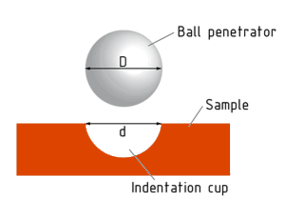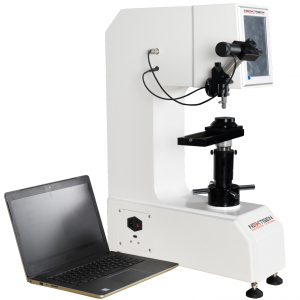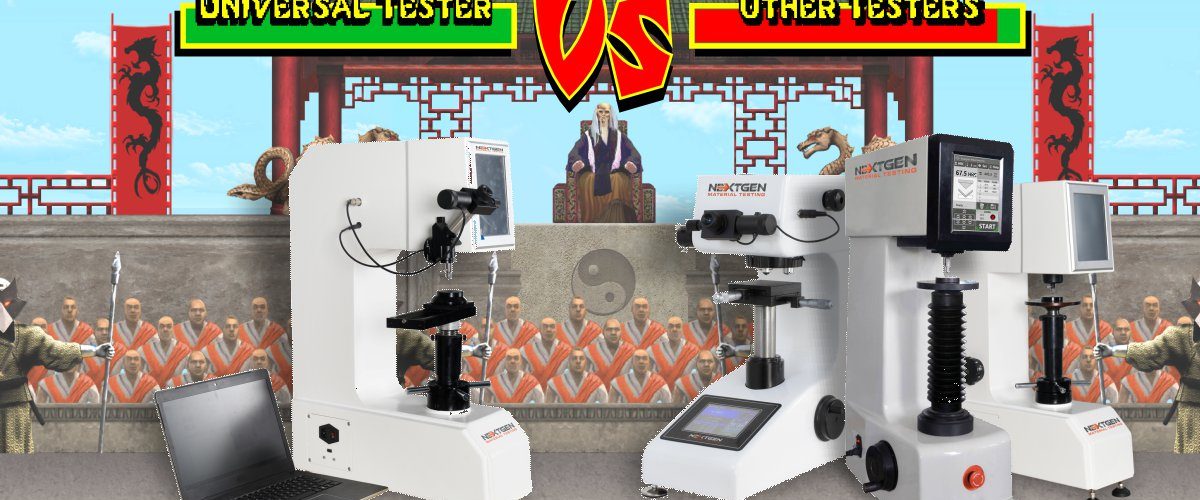Do you want to understand what hardness is, why it should be determined, and how does a hardness tester work? This blog is all about that.
Hardness Tester – Origins
Hardness (as opposed to softness) in materials science is a measure of a material’s ability to resist plastic deformation under external localized impact: indentation, scratching, or abrasion. In other words, a hard material has a greater ability to retain its shape under such external forces.
It is a well-known fact that diamond is the hardest material of natural origin. It is also clear that different materials have different hardnesses. Metals can be as hard as titanium and steel or as soft as copper, gold or lead. Wood is softer than glass, and rubber is softer than wood. But when it comes to comparing the hardness of different grades of steel, the wear resistance of different types of plastic, or the scratch resistance of different enamels, you do need to have clear values that can be compared to each other to choose the best material for creating consumer products. This is where the need for hardness measurement methods comes in.
Mohs Hardness Scale
The first attempt to define hardness through numerical values was made in the early XIX century. As a geologist and mineralogist, German scientist Friedrich Mohs ranked 10 selected minerals according to their ability to scratch each other. Thus, talk, as the softest of them, received a value of 1, and the hardest one, diamond, respectively, 10.
The differences in hardness between the individual grades of the scale are not the same. For example, the difference between grades 9 and 10 is significantly greater than between grades 1 and 9. Around 1900, further testing procedures were developed for technical purposes. In these procedures, hardness is not determined by scratching, but rather by pressing the material to be tested with very hard objects of a certain size and shape. which was the beginning of the widespread use of special hardness testers.
|
Mohs Scale |
Mohs Standard Mineral |
Knoop Hardness Number |
Observations |
|
1 |
Talc |
2 |
very easily scratched with a nail |
|
2 |
Gypsum |
32 |
can be scratched with a nail |
|
3 |
Calcite |
120 |
very easily scratched with a knife or a copper coin |
|
4 |
Fluorite |
150 |
Is scratched very easily with a knife, but not as easily as calcite |
|
5 |
Apatite |
400 |
difficult to scratch with a knife |
|
6 |
Feldspar |
560 |
can’t be scratched with a knife, and difficult with glass |
|
7 |
Quartz |
700 |
easily scratches glass |
|
8 |
Topaz |
1300 |
very easily scratches glass |
|
9 |
Corundum |
1800 |
cuts glass |
|
10 |
Diamond |
6000 |
scratches everything, glass cutter |
Although the Mohs test makes it easy to identify minerals in the field, it is not suitable for accurately measuring the hardness of industrial materials such as ceramics or steel. Other hardness scales, such as the Knoop’s scale, provide a more accurate measure.
The Essence of Hardness – Understanding the Definition
Various sources, from articles on the Internet to scientific publications, say that hardness is a characteristic of a material, but it is not its fundamental property. What does this mean?
The fundamental physical properties of materials are usually related to their chemical composition, molecular and crystal structure. For example, density, electrical conductivity, Young’s modulus (measuring the stiffness of a material), and Poisson’s ratio (characterizing its deformation response) are just a few examples of fundamental material properties. The values of such quantities do not depend on the method of their measurement. That is why they are fundamental. Hardness is not.
What’s wrong with hardness?
-
Hardness is not a fundamental property because it can depend not only on the composition of the material, but also on the treatment of its surface. Treatments such as grinding, polishing, heat treatment, or coating with special materials can make the surface more tough or scratch-resistant, reducing the tendency to wear. Such treatments can also change the appearance of the material, but do not affect its fundamental properties.

-
Another reason why hardness is not a fundamental property of a material is that it is impossible to establish a universal standard, reference method of measurement or a single type of hardness tester. Hardness is measured by a variety of methods that use their own specific scales. This will be discussed below.
-
Hardness is a manifestation of a set of mechanical properties. Hardness alone cannot fully describe the mechanical response of a material. Materials can have the same hardness but different strength, flexibility, toughness, etc. Also, mechanical properties are more complex and include tensile strength, impact strength, toughness under load, etc. In addition, hardness can depend on the scale of the test. For example, macroscopic hardness may differ from microscopic hardness.
With this in mind, it is important to understand that hardness is a measurable characteristic, not a property that is entirely determined by the intrinsic nature of the material. Molecular structure, chemical composition, and crystal lattice are all fundamental aspects that influence hardness, but they are not the only ones. The main thing is that the hardness value can vary depending on the measurement method, so it is not a property, but only a certain technical characteristic.
Not surprisingly, there are three types of hardness: scratch hardness, rebound hardness, and indentation hardness.
Scratch Hardness Test
This is a test of how resistant a sample is to fracture or permanent plastic deformation due to friction against a sharper object that scratches the sample. The examination is performed using special tools, hardness testers. The Martens method uses a diamond cone with a 90° apex angle. The test force is varied to achieve a scratch width of 10 µm, which is measured under a microscope. This way, a specific scratch resistance value can be assigned to the sample and the resulting scratch hardness value can be placed on a comparative Mohs scale. When testing coatings for scratch resistance, the force required to cut through the film down to the substrate is determined.
One such hardness tester, a device called a “sclerometer”, which takes a microscopic measurement of the width of a scratch produced by a diamond under a fixed load and under fixed conditions.
Rebound Hardness Test
Rebound hardness, also known as dynamic hardness, is a test that refers to the elasticity of a material, i.e. its ability to absorb impact energy. In dynamic hardness testing procedures, an indenter is struck against the surface of a specimen. The material of the specimen can deform elastically or inelastically. The deformation caused by the kinetic energy of the indenter can be measured.
In the drop hardness tester (a), an object of a certain mass is dropped freely on the specimen with an indenter (ball), creating an indentation. In the impact hardness tester (b), the ball is placed on the surface of the specimen and an object of known mass is struck by a hammer or spring force and penetrates the indenter. The indentation is measured and a hardness value is assigned by comparison with a standard sample of known hardness.
The working principals of a drop hardness tester (a) and an impact hardness tester (b)
In the classical dynamic hardness measurement technique, the height or rebound angle of a diamond-tipped hammer dropped from a fixed height on the material is determined. This type of hardness is related to elasticity.
In materials with a low deformation potential, such as rubber, the indenter that comes into contact with the surface of the sample springs back. The rebound angle is used to determine the rebound energy and to infer the hardness value.
Modern procedures actually work on slightly different principles, determining the Shore hardness value.
The most advanced hardness testers measuring in measuring Shore scale are supplied by NextGen:
Indentation Hardness Test
In this approach, hardness is measured through the deformation of a material due to static loading by a sharp object. In such hardness testers the results are based on measuring the amount of deformation caused by an indenter of a certain size under a certain load. These conditions determine the measurement result according to generally accepted standard scales, which include, but are not limited to, the Shore, Brinell, Vickers, and Rockwell scales.
The working principals of an indention hardness tester. So an indenter attached to the lower end of the press is forced into the surface of the sample with a certain amount of force and then pulled back. The indentation created can then be measured. The shape and size of the indenter are crucial for indentation resistance. With ball indenters, the sample material is pushed sideways and downward due to the plastic and elastic deformation of the material. Angled or needle indenters can cause cracking and flaking (e.g. for ceramics) in addition to deformation. The penetration rate also affects the behavior of the material under test.
For these reasons, guidelines for hardness test procedures, including hardness tester design, indenter, penetration rate, and optical evaluation system, are of particular importance. The most widespread are the hardness testers currently used, working according to the methods Brinell, Vickers, and Rockwell. They will be discussed further.
Brinell Test
The first indentation method of static hardness testing was introduced at the 1900 Paris World’s Fair by Swedish researcher J.A. Brinell. A Brinell hardness tester uses hardened steel or tungsten carbide balls with a diameter of 1, 2, 2.5, 5 or 10 mm as an indenter. This method uses a ball to press into the smooth surface of the sample with a certain amount of force. To obtain reproducible results, it is important that the sample is supported by a rigid support and that the indenter touches the sample without shaking or jolting. The test force is then increased to the specified maximum level at a specified rate and held for 10-15 seconds. The duration of the load in the Brinell test can vary depending on the material and is up to 180 seconds in the case of non-ferrous metals. If the duration is outside the specified range, the result may not be reproducible. The hardness is determined by the size of the indentation obtained.
Vickers Hardness Test
The Vickers test was developed in the 20s of the XX century by Robert L. Smith and George E. Sandland, who worked for Vickers Ltd. The method uses an indenter tip that is a regular tetrahedral diamond pyramid. This alternative to the Brinell test for measuring the hardness of materials facilitates the measurement because the necessary calculations are independent of the indenter size and it can be used for all materials regardless of hardness. The basic principle of Vickers hardness tester, as with all common hardness measures, is to observe the ability of a material to resist plastic deformation from a standard source. The Vickers test has one of the widest scales among hardness tests. The unit of hardness determined by the test is known as the Diamond Pyramid Hardness (DPH) or Vickers Pyramid Number (HV). The hardness number can be converted to pascal units, but there is confusion here with pressure units, which are also measured in pascals. The hardness number is determined by the load on the surface area of the indentation, not the area perpendicular to the force vector, and therefore it is not really pressure.
Rockwell Test
This test procedure was also introduced in the 1920s. The Rockwell test differs from the two previous approaches described in that it simply measures the depth of penetration of the indenter under a light load (preload) with the depth of penetration under the main load (heavy load). This simplification allows the Rockwell hardness (HR) value to be read from the tester immediately after the main force is removed. In contrast to the Brinell procedure, the Rockwell hardness tester uses simpler measuring machines that do not need to include optical measuring modules. For these reasons, the Rockwell test was quickly adopted and is now widely used primarily for simple and rapid quality control in production.
Hardness Comparison and Conversion
Measuring the hardness of materials on different scales is challenging. Due to the use of different methods, procedures, and parameters, it is difficult or impossible to compare the results. Different hardness testers use different measuring scales, such as Vickers, Rockwell, Brinell, Knoop, and others, they have different ways of loading and measuring the effects of this loading, and each scale has its own measurement range.
Converting results from one scale to another can be a tricky task, as hardness measurement is not a simple conversion of one unit to another. Due to the unique properties of each scale, an accurate conversion can only be guaranteed for a limited set of data obtained under specific conditions.
In addition, the use of hardness scale types may vary from region to region of the world, depending on the country. For example, in the United States, the Rockwell scale is widely used, in Europe both the Rockwell and Vickers scales are frequent, and in Japan some cases are measured using the Brinell scale. Each country has national standards and guidelines for measuring the hardness of materials. This creates certain problems for manufacturers of consumer goods because they have to buy a bunch of different hardness testers, do additional quality control to meet the reglementations put forward by the importing countries.
Organizations such as ASTM International (American Society for Testing and Materials) and CEN (European Committee for Standardization) also develop and publish standards related to hardness measurement that can be used in accordance with regional requirements.
Hardness Tester ISO
At the global level, there are international organizations such as the International Organization for Standardization (ISO) that set standards and guidelines for hardness measurement. They define hardness measurement methods, test conditions, and inspection procedures. For example, ISO 6507 specifies the method of measuring microhardness using the Vickers scale, and ISO 6508 specifies the method of measuring hardness using the Rockwell hardness testers.
Standardization in this area helps to ensure that hardness measurement results are commensurate and comparable between different laboratories and countries. It also helps to establish international guidelines for hardness measurement and to ensure the quality and reliability of measuring equipment.
These differences in methods and standards pose challenges, especially for companies operating internationally. Some comparisons can be made using conversion tables or calculators, but this may not always be the ideal solution for the reasons mentioned above.
“If only there was a machine that could measure hardness according to all common standards… It would be a perfect universal hardness tester!” – manufacturers dreamed. And our company NextGen introduced its solution to the market – UniGen!
UniGen Hardness Tester by NextGen
 UniGen is a universal hardness tester that provides all-in-one hardness measurement. The device is specifically designed to offer industry-leading ease of use, reliability, and accurate results for Vickers, Rockwell, and Brinell hardness measurements. This instrument is everything you need to get your hardness testing work done across multiple standards. Like all other NextGen equipment, the UniGen is industry certified, easy to use, operated via a touchscreen display, has an intuitive interface, and comes with a full set of consumables to get you started.
UniGen is a universal hardness tester that provides all-in-one hardness measurement. The device is specifically designed to offer industry-leading ease of use, reliability, and accurate results for Vickers, Rockwell, and Brinell hardness measurements. This instrument is everything you need to get your hardness testing work done across multiple standards. Like all other NextGen equipment, the UniGen is industry certified, easy to use, operated via a touchscreen display, has an intuitive interface, and comes with a full set of consumables to get you started.
If you’re tired of searching for ways to measure hardness according to this and that standard, UniGen will provide you with a turnkey solution to universalize your testing facilities and free up a lot of time for the really important things.
